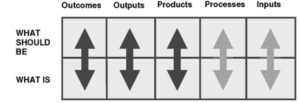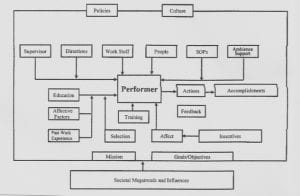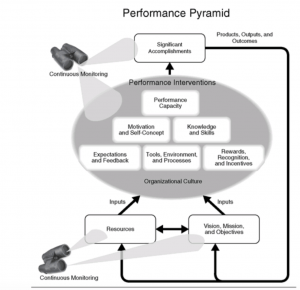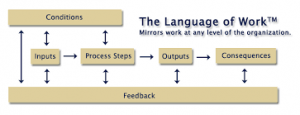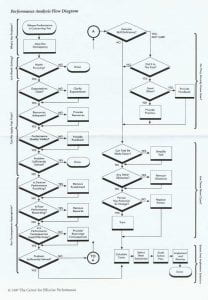In 1978 Gilbert published Human Competence: Engineering Worthy Performance, a book that many recognize as groundbreaking and significant for its contributions to the foundations of HPT. In the book, Gilbert introduced his Behavioral Engineering Model. These concepts are organized as “Leisurely Theorems”. There are four in total, however, the first three are the most notable in their contributions to the field of HPT.
First Leisurely Theorem: Human competence is a function of worthy performance (W), which is measured by the ratio of valuable accomplishments (A) to costly behavior (B)
W = A/B
Leisurely Theorem I introduces the notion of assigning value to workplace performance by measuring its accomplishments, or its worth to the person who requested the work be performed and distinguishes the outcomes from an individual’s behaviors. This is notable when evaluating intervention measures and their ability to impact behaviors and worthy performance. For an intervention to be seen as successful, it is not enough to change behavior, accomplishment (worthy performance) must also be achieved.
Second Leisurely Theorem: Typical competence is inversely proportional to the performance improvement potential (PIP). The PIP is the ratio of exemplary performance to typical performance. The ratio must be stated for an identifiable accomplishment — there is no general quality of “competence.”
PIP = W(e)/W(t)
Leisurely Theorem II analyzes the performance improvement potential by comparing the best performance or desired state to the typical performance. The identification of this gap, for Gilbert, should not be considered a bad thing, but merely a positive, in that it shows the potential for improvement.
Third Leisurely Theorem: For any accomplishment, a deficiency in performance always has an immediate cause in a deficiency in the performer’s behavior repertory (P), or a deficiency in the environment supporting the repertory (E), or both. The ultimate cause is always a deficiency in the management system (M).
W = A/B = A/(P + E + M)
Leisurely Theorem III. outlines conditions of behavior that can be examined and manipulated to improve performance. The conditions are numbered, and when followed practitioners are more likely to uncover the variables that when improved, deliver the greatest gain for the least amount of effort.
![]()
![]()

![]() References:
References:
Gilbert, T. F. (1996). Human competence: Engineering worthy performance, tribute edition. Unspecified.
Chart: http://hpt2014.weebly.com/gilberts-bem.html

